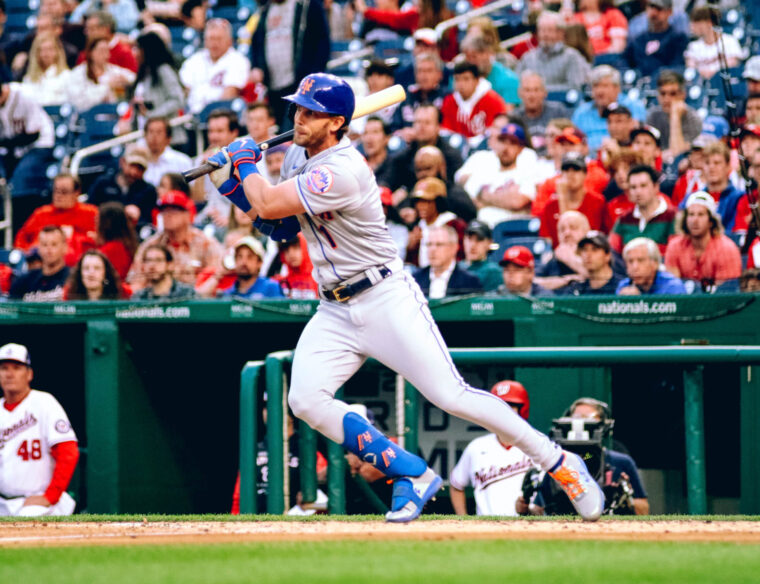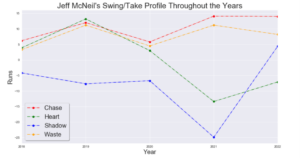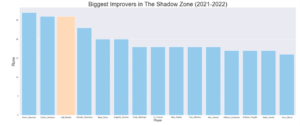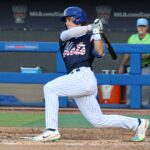
Photo by Roberto Carlo
Note: All swing statistics cited in this article are current through October 2nd, 2022
Despite a disappointing final weekend of the regular season in Atlanta, the Mets finished with one of their best records in franchise history. Jeff McNeil’s turnaround season has been one of the key factors to their success. After an uncharacteristically poor 2021 campaign, McNeil won the batting title and finished with a top-ten single-season batting average in Mets team history.
A quick glance at McNeil’s numbers might indicate that he has simply reverted to the prolific hitter he was during the 2018-2020 seasons. A deeper look, however, reveals that a significant change in hitting philosophy is likely facilitating this 2022 success.
As outlined in this 2019 MMO piece, Statcast Swing Take is a nifty tool that helps better clarify the value added or subtracted by a hitter’s tendency to swing at or take pitches in different areas inside or outside of the strike zone. The tool defines four zones: the ‘heart’ of the plate (pitches that are close to the center of the plate and definite strikes), the ‘shadow’ zone (pitches that are on the edge of the strike zone or just outside of it, and have a 50/50 chance of being called a strike), the ‘chase’ zone (pitches that are clearly not strikes but still within several inches of the zone), and the ‘waste’ zone (pitches that are not at all close to being a strike).
Each hitter in the league records a ‘run value’ for each zone, based on whether they swing at or take each pitch they see in all four zones, as well as the game context of each pitch. The context refers to the count when the pitch was thrown, the number of runners on, and the number of outs; all dictate the amount of run expectancy gained or lost by a swing or take on every pitch a batter faces during a season. Aggregating all of those run expectancies into the four regions of the plate can be a convenient way to quantify how much a hitter’s aggressiveness and patience helps or hurts his team, with a positive run value indicating he was above the league average, and a negative number demonstrating below average performance.
Comparing Jeff McNeil’s 2021 and 2022 Statcast Swing Take profiles provides some fascinating insight into his dramatic turnaround. McNeil’s 2021 rate stats were paltry compared to his career numbers, especially his .251 batting average and .319 OBP, both of which were over 60 points below his career marks before that season. Nevertheless, his 2022 batting average and on-base percentage were very much in line with his 2018-2020 averages.

McNeil’s 2021 Swing Take profile explains the steep downturn in his fortunes that season: He had a cumulative run value of -13, rating well below league average, and correlating well with his disappointing OPS+ of 87, with his swing/take numbers indicating a significant drop in production in both the heart and shadow zones.
In 2021, McNeil was well above league average in the chase and waste regions—with run values of +11 and +14, respectively. That success was primarily because he was able to lay off those pitches, which are clearly balls, at a better rate than average, thus saving himself from either a swing and a miss or weak contact likely to result in an out.
However, in the shadow zone, those pitches that are near the edges of the strike zone and have a roughly 50/50 chance of being called a strike, McNeil’s run value was -25, completely offsetting the +25 gained in the chase and waste regions. McNeil’s unusual aggression led to outcomes of weak contact and swinging strikes. Furthermore, McNeil netted an additional -13 run value on pitches in the heart zone, close to the middle of the plate, also primarily because he swung at those much more frequently than average, and generally had poor outcomes.
In 2022, though, McNeil has completely changed his Swing Take profile, and through October 2, has compiled a robust +23 run value. While his ability to lay off pitches outside of the strike zone in the chase and waste regions has remained relatively consistent, a huge shift has occurred in the shadow region. As outlined in his 2021 recap, the shadow area, with a -25 run value, was by far McNeil’s weakest region. Yet in 2022, McNeil has turned the shadow region into a net positive, with a run value of +5 runs. Only two other qualified hitters have improved their Run-Value in the Shadow Zone as much as McNeil, year over year.

In 2021, he swung at pitches in the shadow region 64% of the time, well above the major league average of 53%. However, in 2022, McNeil has only swung at pitches in the shadow region 59% of the time, which is now much closer to the league average of 54%.
McNeil’s rapidly improved ability to lay off pitches around the edges of the strike zone in 2022 has allowed him to improve from solid to elite levels in several key Statcast batting metrics. While McNeil does not hit the ball particularly hard, ranking well below average in metrics like exit velocity and hard-hit percentage, his ability to find holes is exemplary. However, a disciplined approach is necessary to have the best chance of doing so, and McNeil simply was too aggressive on mediocre pitches in 2021 to be able to do so. The renewed patience in 2022, though, has allowed him to place balls where he wants to with much more frequency, as evidenced by his expected batting average being in the 92nd percentile.
Whether due to a personal shift in hitting philosophy or the impact of coaching, Jeff McNeil has retooled his approach at the plate in the 2022 season. The change has been quite a success, culminating with a standout series versus the Braves, where he batted .539 (7-for-13), while the rest of the Mets’ offense generally sputtered. Given those struggles being experienced by many Mets batters at present, Jeff McNeil’s ability to generate hits will be of vital importance to the team as they embark on their first postseason run since 2016.
Matt Mancuso also contributed to this article














